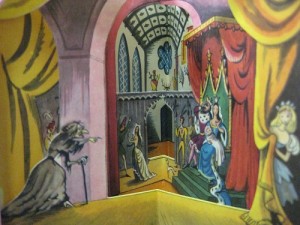
Princesses and Paupers: The Golden Age of Children’s Literature, curated by Ellie Campbell, poster design by Muzel Chen
By: Ellie Campbell, JD and University of Alabama MLIS graduate student
On June 10, 2014, Princesses and Paupers: The Golden Age of Children’s Literature, curated by Ellie Campbell, will be mounted in the Pearce Lobby of the Amelia Gayle Gorgas Library.
In the seventeenth and eighteenth century, European culture, influenced by the writings of John Locke, came to regard children’s minds as a tabula rasa, a blank slate which could be molded with proper instruction. Publishers began to create a new genre: literature intended to educate young minds about the adult world. By the beginning of the nineteenth century in Europe and North America, laws began to prevent child labor and enforce compulsory education, measures which increased literacy rates in the general population. In response, the children’s publishing industry expanded to meet this growing demand just as new developments in printing technology also made books cheaper to purchase, leading to what is now known as the Golden Age of Children’s Literature during the latter half of the nineteenth century.

A scene from A Sleeping Beauty illustrated by Roland Pym, Hoole Library Rare Books Collection PZ8.S38 P42 1951
As the demand and accessibility of children’s literature grew, so did the kinds of stories available; popular authors established a wide number of genres within children’s literature during this period. Collections of fairy tales by the Brothers Grimm, Hans Christian Anderson, Charles Perrault, and others brought those stories to new audiences. Likewise, Lafcadio Hearn collected Japanese folk tales and brought them to international readers. Thomas Hughes pioneered the boarding school story in Tom Brown’s School Days (1857). Lewis Carroll’s Alice in Wonderland (1865) developed fantasy literature for children, and his influence can be seen in later works by Kenneth Grahame. Like Alice in Wonderland, The Wind in the Willows (1908) and “The Reluctant Dragon” (1898) both feature humorous adventure stories and anthropomorphic animals. Charles Dickens and Frances Hodgson Burnett wrote about the effects of a newly industrialized and imperialistic world on children in coming-of-age works like Oliver Twist (1838), Great Expectations (1861), Little Lord Fauntleroy (1885-6), and The Little Princess (1905). Robert Louis Stevenson and Rudyard Kipling popularized adventure stories such as Treasure Island (1883), Kidnapped (1886), The Jungle Book (1894), and Kim (1901), and Mark Twain brought those narratives into the American idiom in The Adventures of Tom Sawyer (1876) and The Adventures of Huckleberry Finn (1884). Louisa May Alcott took Dickens’ and Twain’s coming-of-age tales and adapted them for young girls in Little Women (1868) and its popular sequels.
In addition to the variety of new genres for children, advancements in the publishing industry also contributed to the growth of children’s literature. In the early nineteenth century, publishers responded to growing literacy rates and the corresponding demand for more and cheaper books by binding books in cloth rather than leather. Books bound in cloth could be produced en masse, unlike leather-bound books which were created by hand. Publishers’ bindings, as they were known, utilized gold and silver foil stamps, bright colors, and illustrations that reflected the topics or themes of the work. While many of these books were aimed at adults, the decorations were especially appealing to children. The bindings also reflected developments in the art and advertising industries, incorporating trends like neoclassicism, the gothic revival, art deco, and interest in Egyptian and Japanese design.
The wide range of children’s literature produced in the Golden Age and the simultaneous development of a publishing industry that catered to a younger market continue to influence children’s and young adult fiction to this day. Harry Potter’s fantasy world and the adventures of Katniss Everdeen in The Hunger Games find their origin in nineteenth century stories that describe the wonders of magic, the drudgery of boarding school, and the rise of imperialism.
